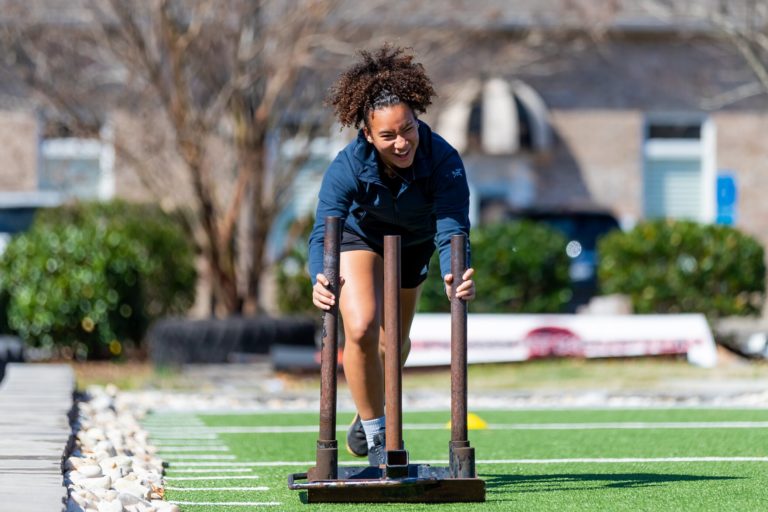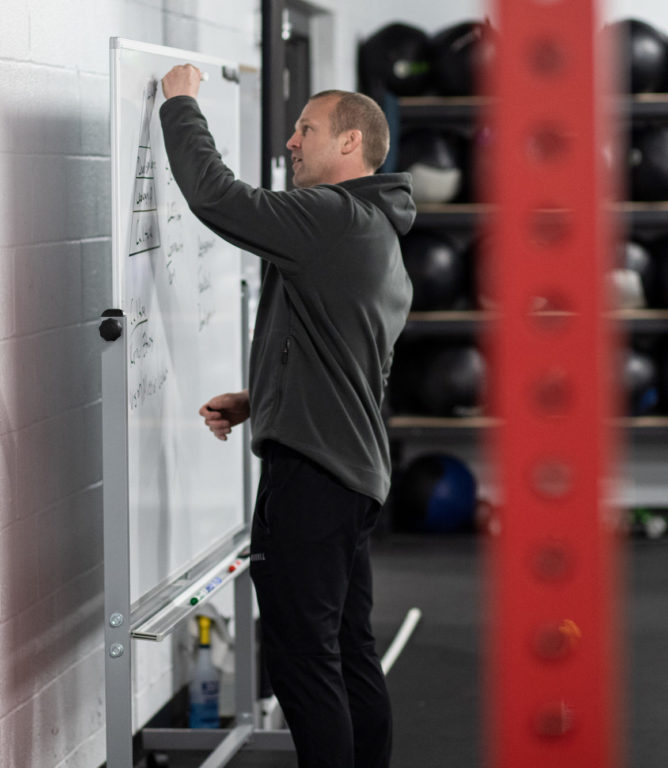Browse the web or talk with friends who do CrossFit and you will easily understand that working at high intensity levels is a big piece of our program. In fact, our definition of CrossFit — constantly varied functional movements executed at high intensity — says exactly that!
There is a reason we demand intensity, and it has nothing to do with associated novelties like physical discomfort, grunting, finding yourself on the floor in a puddle of your own sweat, etc. While all of these things are great and may actually be indications that you hit high intensity in your workout, the real reason we need intensity is the results that are acquired when we achieve it.
“Intensity is the independent variable most commonly associated with maximizing your rate of return on favorable adaptation.” —Greg Glassman, Founder of CrossFit
If you’re anything like me, you read the quote above and thought to yourself: “What the heck does that mean?” In simpler terms, intensity is the pathway to results. When we say “results,” we mean actual measurable markers that demonstrate improvements in physical performance (improved strength numbers, improved running times, better gymnastics, etc.) and improvements in measurable classic health markers (body-fat percentage, resting heart rate, bone density, blood markers, etc.).
 Putting yourself through more physical discomfort, grunting louder, or sweating more does not equate to intensity and, by extension, results. Instead, the results come when you push past your comfort zone without overly compromising the quality of your movements. This is how you increase your work capacity — or fitness — which you know you’ve done if you find you’re able to finish a variety of workouts faster or to lift heavier loads over time. When this happens, not only are you seeing better physical performance, but improvements in your health markers will follow, especially when your training is combined with our nutritional protocols based around eating whole, unprocessed, quality foods in the right quantities.
Putting yourself through more physical discomfort, grunting louder, or sweating more does not equate to intensity and, by extension, results. Instead, the results come when you push past your comfort zone without overly compromising the quality of your movements. This is how you increase your work capacity — or fitness — which you know you’ve done if you find you’re able to finish a variety of workouts faster or to lift heavier loads over time. When this happens, not only are you seeing better physical performance, but improvements in your health markers will follow, especially when your training is combined with our nutritional protocols based around eating whole, unprocessed, quality foods in the right quantities.
High intensity may seem intimidating, but no need to fear; our program is accessible to anyone. Many people see videos online depicting intensity in the gym, or the CrossFit Games highlight reels, and they assume CrossFit is only for elite athletes who can push themselves into the “pain cave.” On the contrary, in our program, intensity is relative to the individual and their physical and psychological tolerances. Our program is infinitely scalable to meet any individual at any fitness level. Can’t do a bodyweight squat, a push-up, or run? That’s OK! You can walk into one of our 13,000 CrossFit gyms and the coaches can adapt any workout to meet you where you are. Each workout has a goal — a stimulus — to achieve. The intended stimulus will inform how you scale the workout. CrossFit’s highly credentialed coaches can help you understand the stimulus so you can scale in a way that ensures you push your physical boundaries, move at an appropriate speed, and use an appropriate load, all while maintaining technical proficiency. Managing this process is difficult on your own, so guidance from a qualified coach is invaluable.
Intensity Matters but Consistency Matters More
The allure of intensity can often overshadow the true driver of long-term results: consistency. This isn’t what people want to hear, but it’s reality. What keeps people hooked on CrossFit initially are the results they see in a short time — it’s truly unparalleled. But what good are those results if you stop after a few months or even a year? We want consistency for years — even decades. Creating a consistent habit of working out a few times a week at your relative intensity along with consistent (not perfect) clean-eating practices for years is a better driver of long-term results than working out six to seven days a week with perfect nutrition, as the latter is not sustainable. Unfortunately, this overzealous approach is common — especially after the holiday season.
“Strength and conditioning gains come fastest for athletes who hold the highest average intensity over sustained periods. Consistency must be established at any general intensity level before it is appreciably turned up, or the specter of burnout looms. Countless people have after three spectacular CrossFit workouts stated a preference for a fiery death over coming back for a fourth workout. They went too hard – too intense.” —Greg Glassman, “A BEGINNERS GUIDE TO CROSSFIT”
Consistency can be hard, and many rely on daily motivation — but motivation is often fleeting and we must be able to fall back on habits and discipline if we’re to be successful. Create habits and routine so exercise and nutrition are a normal part of your day. The accountability and community atmosphere of a CrossFit gym may be a key ingredient for driving consistency, especially during times when motivation is lacking.
Beyond the Physical
The benefits of working at high intensity levels extend beyond the physical — your psychological tolerances can expand as well.
“The greatest adaptation to CrossFit takes place between the ears.” —Greg Glassman
In CrossFit, you will be consistently challenged relative to your ability. Through these challenges, you’ll develop a level of grit and determination you may not know you had. These benefits extend beyond the gym walls and will have a positive impact on every aspect of your life, driving you to tackle any adversity or adventure that comes your way, even well into your 80s and 90s.
“In every workout you kind of get to a point where … you have a choice: You can give up or you can finish. And what I learn from doing it is every single day, when you get to that point and you either quit or keep going, you’re training a muscle to either quit or don’t quit. And you do that so many times for so many years and then you get something like really hard … that muscle’s ready for that.” —Tim Ryerson in “HOW TO GO FROM QUIT TO GRIT,” by Brittney Saline
Getting Started
Whether you’re pursuing fitness for the first time or starting again after some time away, build your routine gradually — remember, we are playing the long game. There is more to be gained from doing less initially, and practicing technique, than there is by doing too much. Take it one day at a time and see how you feel after each workout. If your soreness levels are low and you’re feeling good after a week or two, crank up the intensity a little, and repeat this process. Over time, you will be achieving things you didn’t think were possible.
The same holds true for nutrition. Crash dieting, when people have strict adherence to a diet for a few months and then completely fall off the wagon, is rarely successful. For some, going “all-in” right away might work. More often, though, focusing on doing one or two things better consistently and adding more improvements over time is the road to success. You do not need to be perfect to see progress. Strive for sustainability. If you can reach a point where you are working out consistently and eating whole foods 80-90% of the time, and you maintain this for years, you will reap lasting benefits that will accumulate as you age.
About the Author

Eric O’Connor is a Content Developer and Seminar Staff Flowmaster for CrossFit’s Education Department and the co-creator of the former CrossFit Competitor’s Course. He has led more than 400 seminars and has over a decade of experience coaching at an affiliate. He is a Certified CrossFit Coach (CF-L4), a former Division 1 collegiate wrestler, and a former CrossFit Games athlete.
Is CrossFit Too Intense for Me?